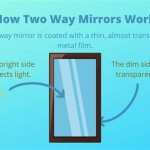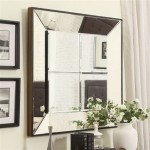How To Hang a Mirror on Tiles
Hanging a mirror on a tiled surface requires careful planning and execution to avoid damaging the tiles. This process differs from hanging on drywall and requires specific tools and techniques to ensure a secure and lasting hold.
The initial step involves assessing the size and weight of the mirror. Heavier mirrors will require more robust hanging mechanisms. Measure the mirror's dimensions and note its weight. This information will guide the selection of appropriate hardware.
Selecting the right hanging hardware is crucial. Traditional picture hooks are unsuitable for tiled surfaces. Adhesive hooks may work for lightweight mirrors, but for heavier mirrors, specialized mirror clips, J-hooks, or French cleats are recommended. Mirror clips offer discrete support and are suitable for frameless mirrors. J-hooks provide a more visible hanging method and are compatible with framed mirrors. French cleats offer the strongest support for heavy mirrors and involve mounting a cleat to both the wall and the back of the mirror. The weight limit of the chosen hardware should exceed the mirror's weight for safety.
Before drilling, it's essential to locate the wall studs. While studs don't factor into the direct attachment on tile, knowing their location helps in avoiding them when drilling pilot holes. A stud finder can be used to pinpoint their location.
Marking the desired mirror position on the tiles is the next step. Use a pencil or masking tape to outline the mirror's perimeter. Then, identify the exact points where the hanging hardware will be attached. Precision in marking is crucial for a level and secure installation.
Drilling into tile requires special drill bits. Standard drill bits are prone to slipping and cracking the tile. Diamond-tipped or carbide-tipped drill bits designed specifically for tile and glass are recommended. Before drilling, apply masking tape over the marked points. The tape helps prevent the drill bit from slipping and minimizes potential chipping.
Start drilling slowly at a low speed, applying gentle pressure. Avoid forcing the drill bit, as this can cause the tile to crack. Once the hole is created, insert wall anchors appropriate for the tile and the chosen hardware. Wall anchors provide a secure grip within the tile and prevent the hardware from pulling out.
Once the anchors are in place, attach the chosen hanging hardware according to the manufacturer's instructions. Ensure the hardware is securely fastened to the wall anchors before attempting to hang the mirror.
With the hardware securely attached, carefully lift the mirror and engage it with the installed hardware. For mirrors with clips, ensure the clips are properly aligned and tightened. For J-hooks, place the hanging wire or D-rings on the hooks. For French cleats, align and interlock the two cleat sections.
After hanging the mirror, use a level to ensure it is straight. Minor adjustments can be made by loosening and tightening the hardware as needed. Once the mirror is level and secure, carefully clean any fingerprints or smudges from the mirror surface and surrounding tiles.
Specific safety precautions are essential when hanging a mirror on tile. Wear safety glasses during the drilling process to protect eyes from dust and debris. Use a dust mask to avoid inhaling tile dust. Handle the mirror with care to prevent breakage and injury. If working with a particularly heavy mirror, enlist the help of another person for lifting and positioning.
Different types of tiles may require slight modifications to the process. Porcelain and ceramic tiles are generally harder and may require more force and specialized drill bits. Glass tiles are particularly fragile and require extra care and precision when drilling. Consult with a professional if unsure about the best approach for a specific tile type.
Choosing the right adhesive for adhesive-based hanging methods depends on the mirror's weight and the tile type. Ensure the chosen adhesive is specifically designed for use on tiles and has a weight capacity that exceeds the mirror's weight. Always follow the manufacturer's instructions for application and curing time.
Troubleshooting common issues can save time and frustration. If the drill bit slips during drilling, try using a center punch to create a small indentation for the drill bit to grip. If the hole is too large for the wall anchor, use a larger anchor or fill the hole with a suitable filler before re-drilling. If the mirror isn't hanging level, adjust the hardware or add shims behind the mirror to achieve the desired alignment.

How To Hang Mirrors On Tile 3 Ways A Bonus The Palette Muse

How To Hang Mirrors On Tile 3 Ways A Bonus The Palette Muse

How To Hang A Mirror On Tile Wall Remington Avenue

How To Hang Mirrors On Tile 3 Ways A Bonus The Palette Muse

How To Hang A Bathroom Mirror Over Tile Wainscoting Mimzy Company

Tutorial How To Hang A Bathroom Mirror The Diy Playbook

How To Hang A Mirror On Tiles New Zealand Handyman

How To Hang A Bathroom Mirror Over Tile Wainscoting Mimzy Company

Tutorial How To Hang A Bathroom Mirror The Diy Playbook

How To Hang A Mirror On Tile Wall Remington Avenue








